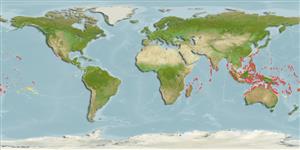>
Ovalentaria/misc (Various families in series Ovalentaria) >
Pomacentridae (Damselfishes) > Pomacentrinae
Etymology: Chrysiptera: Greek, chrysos = golden + Greek, pteron = fin, wing (Ref. 45335).
Eponymy: Sir Robert Brownrigg (1759–1833) was an army officer and colonial administrator. [...] (Ref. 128868), visit book page.
Environment: milieu / climate zone / depth range / distribution range
Ekologi
marina revassocierade; ej vandrande; djupintervall 0 - 12 m (Ref. 9710). Tropical; 32°N - 30°S
Indo-Pacific: East Africa to Marquesan and Society islands, north to Japan, south to Australia.
Size / Vikt / Age
Maturity: Lm ? range ? - ? cm
Max length : 8.0 cm TL hane/ej könsbestämd; (Ref. 9710)
Short description
Bestämningsnycklar | Morfologi | Morfometri
Taggstrålar i ryggfenan (totalt) : 13; Mjukstrålar i ryggfenan (totalt) : 12 - 13; Taggstrålar i analfenan: 2; Mjukstrålar i analfenan: 11 - 13. This species occurs in 2 basic color phases: a blue-backed (leucopoma) phase and a gray to black (amabilis) phase usually with 2 light bars (Ref. 37816). Large blue-edged black spot at end of dorsal fin base, and yellow form with black spots at end of dorsal fin and its base (Ref. 48636). Body depth 2.3-2.5 in SL (Ref. 90102).
Adults occur in rubble-strewn surge channels, the outermost reaches of exposed reef flats, and the upper submarine terrace at 12 meters. Territorial but they generally occur in groups, and remains close to shelter. Feed mainly on benthic algae and small crustaceans (Ref. 1602, 37816 ). Oviparous, distinct pairing during breeding (Ref. 205). Eggs are demersal and adhere to the substrate (Ref. 205). Males guard and aerate the eggs (Ref. 205). Diurnal species (Ref. 54980; 113699).
Life cycle and mating behavior
Könsmognad | Reproduktion | Lek | Ägg | Fecundity | Larver
Oviparous, distinct pairing during breeding (Ref. 205). Eggs are demersal and adhere to the substrate (Ref. 205). Males guard and aerate the eggs (Ref. 205).
Allen, G.R., 1991. Damselfishes of the world. Mergus Publishers, Melle, Germany. 271 p. (Ref. 7247)
IUCN Red List Status (Ref. 130435: Version 2024-2)
Threat to humans
Harmless
Human uses
Fiskeri: mindre kommeriell; Akvarium: Kommersiell
Verktyg
Special reports
Download XML
Internet-källor
Estimates based on models
Preferred temperature (Ref.
123201): 25.4 - 29.3, mean 28.4 °C (based on 2701 cells).
Phylogenetic diversity index (Ref.
82804): PD
50 = 0.5000 [Uniqueness, from 0.5 = low to 2.0 = high].
Bayesian length-weight: a=0.01479 (0.00651 - 0.03363), b=3.00 (2.81 - 3.19), in cm total length, based on LWR estimates for this (Sub)family-body shape (Ref.
93245).
Trofisk nivå (Ref.
69278): 2.7 ±0.3 se; based on diet studies.
Resiliens (Ref.
120179): Hög, lägsta populationsfördubblingstid mindre än 15 månader (Preliminary K or Fecundity.).
Fishing Vulnerability (Ref.
59153): Low vulnerability (10 of 100).
Nutrients (Ref.
124155): Calcium = 152 [84, 266] mg/100g; Iron = 0.934 [0.573, 1.490] mg/100g; Protein = 18.6 [17.5, 19.6] %; Omega3 = 0.143 [0.086, 0.231] g/100g; Selenium = 19.1 [10.8, 35.1] μg/100g; VitaminA = 142 [48, 433] μg/100g; Zinc = 2.41 [1.65, 3.39] mg/100g (wet weight);
